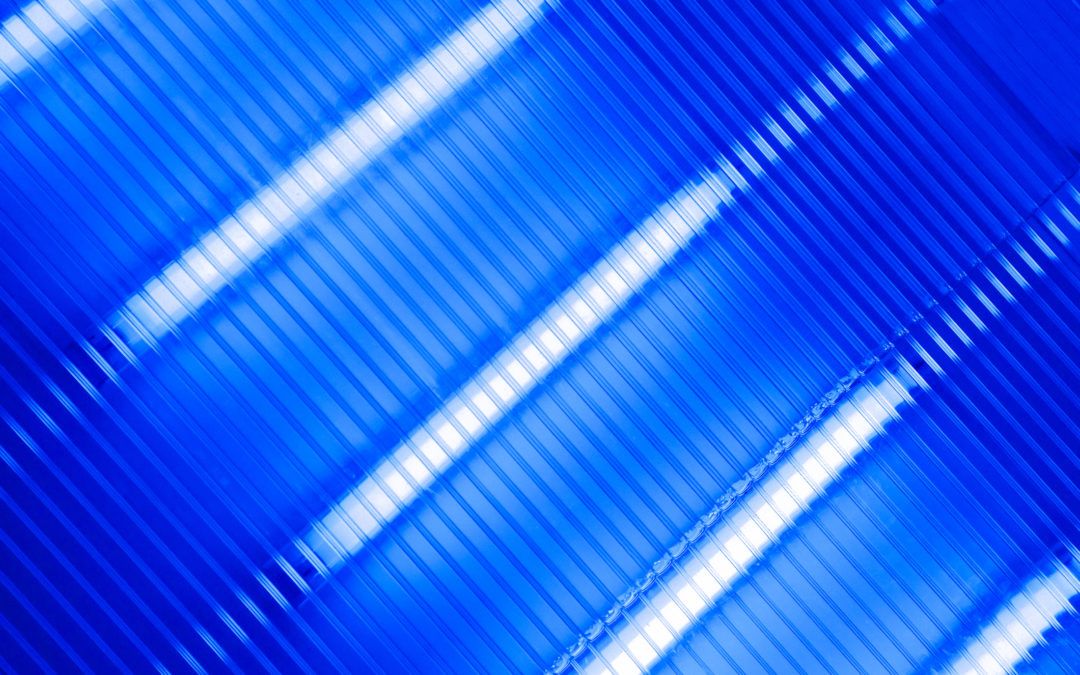UV lamps used in UVGI systems vary widely in size, shape, and power input/output. They utilize wavelengths in the UVB or UVC range, between 100 and 320nm. While the most common UV lamps are high intensity discharge (HID) lamps and low-pressure mercury vapor lamps, standard lamp types include:
- Low pressure lamps
- Medium pressure lamps
- Microwave UV lamps
- Light Emitting Diodes (LEDs)
UV lamps are known to have mercury or mercury alloy which control pressure within the lamp and are paired with a gas enclosed in the glass chamber. The features of each lamp type tend to produce different results during use. For example: with low pressure lamps, much less ozone is produced during operation because of the narrow spectrum of UVC. Medium pressure lamps tend to cover wider range of UV wavelengths and are known to have detrimental effects on enzymes within a pathogen which may enable photoreactivation or self-repair.
UV Lamps are paired with ballasts which provide the lamps with the necessary voltage and amperage to operate properly. As current (amperage) passes through the lamp electrodes, the gas in the UV lamp tube is ionized. The vapor heats up, resulting in both ultraviolet and visible light. The specialized glass of a UV lamp is traditionally made from quartz and readily allows UV light to pass through, as opposed to standard glass types which inhibit UV light transmission.
The power of UV lamps is standardly rated by nominal input watts and nominal UV output watts. The ratio between the input watts and the UV output watts is standardly used to provide the efficiency of the lamp. Most UVG lamps operate at maximum efficiency at 77 degrees Fahrenheit. As temperatures deviate from this optimal value, the UV output will decrease. Lamp UV output is a function of mercury vapor pressure, which is controlled by lamp surface cold spot temperature (the coldest temperature on the lamp surface), air velocity, lamp type, and lamp orientation (Kowalsky, 2009) (Lau J, 2008).
What about Ozone generation? Are these units safe to operate inside?
- Background on Ozone:
- Ozone is generated when normal air is exposed to wavelengths between 175 and 210nm. While ozone has the capacity to disinfect, it also does present hazards to indoor spaces including detrimental effects on humans/animals as well being a powerful oxidizer. Certain organic materials and plastics may also be affected. In recognition of the dangers of ozone many manufacturers have developed specialized glass for their lamps that actively blocks a range of UV wavelengths that produce of ozone. In certain application of UVGI, the air diffusion alone serves to dissipate ozone to close to non-detectable levels (Kowalsky, 2009).
- The CDD does not generate Ozone:
- The CDD units come standard is with lamps that do not emit Ozone. The lamps used in a CDD device have been verified by the manufacturer to operate above the wavelengths levels that produce ozone, thus zero Ozone emissions
How long do lamps last? What’s the maintenance?
- The general guidelines state that UV lamps must be replaced once every year. Lamp lifetimes vary and the manufacturer should be consulted on lamp useful lifetime expectations. Lamps can easily be damaged in shipping or during handling so extreme care should be take while coordinating to install or replace them. For example, it is imperative for the installer or maintenance contractor to utilize clean rubber or latex gloves while handling the lamps as any oil or dirt applied to lamp will only serve to reduce its UVGI effectiveness, reduce its lifetime, or both! If there are noticeable blemishes, dirt or oil on the lamps it is advised to use a clean cloth with rubbing alcohol to clean the glass.
- While temperature affects the performance of the lamps, extreme and/or fluctuating temps may reduce the lifetime of the lamps.
- It is imperative to check the status of you lamps regularly. CDD units come outfitted with LED status indicators which allow the owner, contractor, or maintenance professional to check on the lamp status while the system is operating without exposing themselves to harmful effects of UV. If the LED indicators illuminated in Green the system is operational. Contact 50 Cities or your maintenance pro if a LED indicator is not illuminated while the system is operating. See our installation and maintenance manual for more info.
- While the Continuous Disinfection Device is running a MERV 7 filter protects the inside of the air chamber from accumulating dust and particulates which may reduce the effectiveness of the unit and the lifetime of the lamps. It is recommended that the filter is changed after the first 30 days of operation and every 6 months thereafter. See our installation and maintenance manual for more info.
Conclusion:
UV lamps are sensitive pieces of equipment that vary in shape, size, power requirements, UV ranges and application. They generally use a gas enclosed in the lamp to maximize the production of UV wavelengths. Generally, manufacturers have reduced the risks associated with ozone exposure, but it is best to consult with them prior to use. When UV lamp’s primary use is UVGI, the user should pay close attention to the lamp’s operational status, it being integral to successful disinfection of the space.
For more information or custom quotes for an extraordinary disinfection system please contact us.

